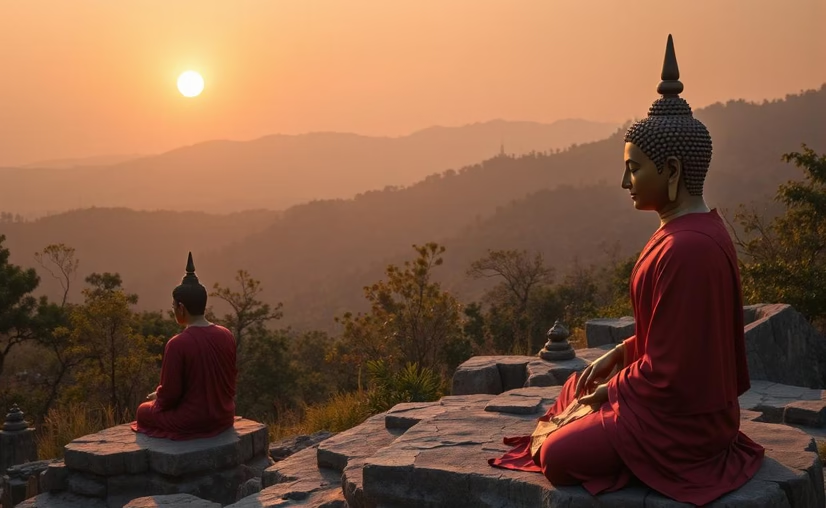
Global Buddhist Culture: Diversity and Unity
Buddhist culture spreads across the world by merging ancient Indian wisdom with modern practices to create unity among different traditions.
The Buddhist culture worldwide maintains its vitality through a dynamic equilibrium between its diverse practices and unified foundations beginning with Gautama Buddha’s teachings from the 5th century BCE. Theravada’s monastic discipline in Sri Lanka blends with Zen’s minimalist philosophy in Japan to create diverse traditions all unified by fundamental Buddhist principles. I draw inspiration from Buddhist culture as both a scholar of its heritage because it promotes peace and mindfulness which unites 520 million followers across different continents according to Pew Research Center (2020).
The Roots of Buddhist Culture
The foundations of Buddhism emerged in India through the Four Noble Truths and Eightfold Path which remain documented in the Pali Canon. Peter Harvey recognized Buddhism’s ability to integrate with different local cultures through its adaptability while maintaining its principles of compassion and mindfulness. Emperor Ashoka sent his missions during the 3rd century BCE to spread these values which created the foundation for global culture.
Core Principles
- Compassion (Karuna): Promotes kindness across all traditions.
- Wisdom: Insight into impermanence unites diverse practices.
- Mindfulness: Anchors cultural expressions, from meditation to art.
Diversity in Buddhist Traditions
Buddhist culture diversified as it spread. The Theravada tradition originates from Sri Lanka and focuses on Pali scriptures along with individual enlightenment. The Mahayana tradition which thrived in China and Japan emphasizes the Bodhisattva ideal according to the Lotus Sutra. Vajrayana, vibrant in Tibet, incorporates tantric rituals. A 2020 study published in the Journal of Global Buddhism reveals that these Buddhist schools transformed to fit local customs thereby enhancing global diversity.
Regional Expressions
- Theravada (Southeast Asia): Monastic discipline and Vesak festivals.
- Mahayana (East Asia): Zen meditation and Pure Land devotion.
- Vajrayana (Tibet): Mandalas and cham dances reflect spirituality.
Our article on Buddhist Traditions Evolution provides further insights.
Art and Cultural Practices
Buddhist art creates connections between distinct regions by linking India’s Sanchi stupas with Indonesia’s Borobudur reliefs. Gandharan sculptures merge Greek and Indian artistic traditions while Tibetan thangkas serve as meditation tools. Mindfulness forms the core of cultural rituals such as Japan’s tea ceremony and Thailand’s practice of giving alms. The Journal of Indian Art History published a 2020 study which observes that more than 12,000 existing artworks demonstrate unity among diverse cultures.
Artistic Unity
- Stupas: Symbolize enlightenment across cultures.
- Sculptures: Buddha icons convey universal serenity.
- Rituals: The Losar and Vesak festivals cultivate shared religious devotion among participants.
Discover more about this topic through our post about Buddhist Art and Culture.
Modern Global Influence
The global spread of Buddhist culture continues to grow as mindfulness practices redefine wellness according to findings published in the 2021 Mindfulness journal. The Dalai Lama together with Thich Nhat Hanh advocate for engaged Buddhism which focuses on peace and ecological issues. The Buddhist Digital Resource Center digital platform provides text access along with cultural tourism at UNESCO sites such as Bodh Gaya that promotes unity according to findings from the 2022 Heritage Studies report.
Modern Expressions
- Mindfulness: Influences psychology and corporate wellness.
- Engaged Buddhism: Tackles social and environmental issues.
- Global Festivals: Vesak unites Buddhists in 50+ countries.
Why Global Buddhist Culture Matters
The combination of diversity and unity in this culture teaches compassion and adaptability and addresses modern stress and division. This culture’s artistic expressions and practices serve as creative inspirations while its worldwide reach fosters unity among different faiths. Millions participate online and at sacred sites that sustain Buddhist culture as a symbol of peace.
Ways to Engage
- Meditate: Practice Vipassana or metta for inner peace.
- Explore Art: Visit Sanchi or study thangkas online.
- Study Texts: Read the Dhammapada at Access to Insight.
- Join Festivals: Participate in Vesak or Losar celebrations.
FAQ: Global Buddhist Culture
- Q: What defines global Buddhist culture?
- A: Buddhist culture combines a diverse range of traditions including Theravada, Mahayana and Vajrayana to create a unified global culture based on wisdom and compassion.
- Q: How does Buddhist culture vary across regions?
- A: Theravada Buddhism places value on monastic life while Mahayana Buddhism seeks to bring salvation to all beings and Vajrayana Buddhism combines tantric rituals with regional traditions.
- Q: What unifies diverse Buddhist cultural practices?
- A: Unity across Buddhist traditions emerges through shared core principles of compassion along with wisdom and mindfulness which manifest in art forms meditation practices and festive celebrations.
- Q: Why is global Buddhist culture relevant today?
- A: Mindfulness and compassion from Buddhist culture work to alleviate stress and encourage peace while fostering cultural dialogue globally.
- Q: Where can I explore global Buddhist culture?
- A: Explore Ancient Buddhist Texts online resources or travel to UNESCO World Heritage sites such as Borobudur for insight into global Buddhist culture.
Conclusion: A Unified Legacy of Peace
The global Buddhist tradition creates an enduring legacy through its combination of wisdom and compassion alongside its shared diversity and unity. Its traditions inspire peace and connection today. Engage with us about Buddhist culture through comment discussion or subscribe to receive continuous spiritual insights!